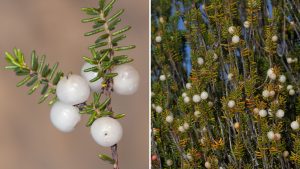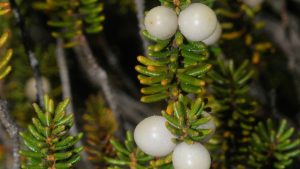In the vastness of Portuguese flora, a plant stands out for its singular beauty: the Portuguese crowberry (Corema album). The Portuguese crowberry is quite common in certain coastal regions of Portugal. This unique and fascinating species has a rich cultural history, outstanding botanical characteristics and plays a vital role in Portugal’s coastal ecosystems.
The Portuguese crowberry (Corema album), from the Ericaceae family, is a rare gem in coastal landscapes. Dubbed a Portuguese treasure by the naturalist Andrade e Silva in 1815 and a phytomonument by Carlos Pinto Gomes, lecturer at the School of Science and Technology of the University of Évora, the absolute potential of this species is still relatively unknown.
The Portuguese crowberry is a shrub with long-lasting leaves and can be found nearly everywhere in dune areas and rocky cliffs, and in pine and juniper tree forests. Its structure is compact and the leaves, narrow and dark green and arranged spiral shape along the branches, albeit delicate, are highly resistant to high temperatures.
This plant is endemic to the Iberian West and Macaronesia, namely the Azores, where this population belongs to the subspecies Corema album, azoricum subspecies and occurs in the islands of S. Miguel, Pico, Faial, S. Jorge and Graciosa. In the Iberian Peninsula, Portuguese crowberries occur in the coastal regions of the Southwest. They can be seen all over the coast in mainland Portugal, especially in the western coastal regions between Nazaré and Ovar and between Sines and Tróia. This species adapts to sandy and poor soils, resists extreme conditions and water scarcity, and is often found in dunes, rocky cliffs and coastal areas, such as the Natural Park of Southwest Alentejo and Costa Vicentina.
It’s a dioecious shrub displaying unisexual, female or male flowers – and some male plants have hermaphrodite inflorescences (between 1% and 4% of the plants). These inflorescences sprout between March and May and are composed of up to 20 small flowers, and are easily unnoticed. But there is something that does not go unnoticed and that’s the small pearled fruits generated by female plants: these edible, translucent, white or pink berries, with a unique, fresh, sweet or acidic flavour, are also dubbed crowberries and ripen in late August and September.
As for its reproduction, this species is pollinated with the help of the wind and is thus called anemophile. The dissemination of seeds, two to four per drupe or berry, is zoochoric, that is, occurs with the help of several species of animals, such as gulls, blackbirds and rabbits, which feed on its fruits and disseminate the seeds.
Despite its size, it plays a crucial role in coastal ecosystems, stabilising soils in areas vulnerable to erosion, thus helping preserve dunes and offering protection against storms. It is also a pioneer plant that can colonise degraded environments and start ecological succession processes.
The Portuguese crowberry has been used by local communities for a long time. Its fruits, also known as pearls of the Atlantic, were harvested and consumed fresh, as appetisers and were also used to prepare lemonades and produce liqueurs and typical sweets, such as jams or jellies, and even cookies. Culturally, it is often associated with local traditions and festivities.
The Portuguese crowberry also has health benefits due to its antioxidant and anti-inflammatory properties and is a source of nutrients such as calcium, iron and zinc. Its leaves and fruits contain characteristics that may help fight oxidative stress, the main cause of liver disease and Parkinson’s disease, and are reported to have anticancer properties too. It can also help reduce inflammations, relieve digestive problems and its antimicrobial properties assist in the treatment of bacterial and fungal infections.
Despite being a symbol of the wealth and biodiversity of Portugal’s coastal ecosystems and their ecological, cultural and medicinal importance, the Portuguese crowberry faces significant conservation challenges. Degradation of its habitat due to urban development, tourism and climate change poses a growing threat to the survival of this species. In order to protect and preserve this plant for future generations, joint efforts have to be put in place to preserve it and raise awareness about its unique importance in the context of the Portuguese flora, and to preserve and ensure proper management of coastal ecosystems.





